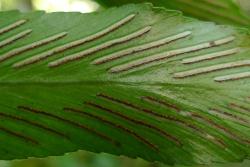Terrestrial, rupestral or epiphytic ferns. Rhizomes erect or short- to long-creeping, bearing clathrate scales. Fronds monomorphic or rarely dimorphic, not articulated to rhizome. Laminae undivided or 1-pinnate to 4-pinnate-pinnatifid, anadromous, membranous (not NZ) or herbaceous to coriaceous (NZ), usually bearing clathrate scales and sometimes hairs. Veins usually free or rarely reticulate (not NZ). Sori elongate on veins, superficial, borne on abaxial surface, usually away from margins but sometimes submarginal; paraphyses absent; indusia rarely absent, usually elongate with free ends, rarely very short or pouched, usually attached to one side of vein or rarely back to back on both sides; sporangial maturation mixed. Sporangia with vertical annulus, usually 64 or occasionally 32 spores per sporangium. Homosporous; spores monolete, lacking chlorophyll; perispores winged, cristate or echinate or reticulate, with plain or fenestrate or reticulate areoles.
A family of two genera and over 700 species (PPG 1 2016). Almost all authorities recognise the Aspleniaceae as a clearly defined, monophyletic, and cytologically homogeneous family, although its affinity with other families is less clear (Kramer & Viane 1990; Smith et al. 2006). It appears most closely related to five small, recently circumscribed families which together comprise only about 50 species – Cystopteridaceae, Rhachidosoraceae, Diplaziopsidaceae, Desmophlebiaceae, and Hemidictyaceae – and beyond them to Woodsiaceae, Onocleaceae, Blechnaceae, Athyriaceae, and Thelypteridaceae (Rothfels et al. 2012; PPG 1 2016). Within Aspleniaceae the vast majority of species have traditionally been recognised as belonging to Asplenium, but a small number have been variously treated in up to 10 satellite genera. Molecular and cytological data suggest that most of these, including Phyllitis and Pleurosorus, nest within Asplenium, leaving Hymenasplenium as sister to the rest of the family (Murakami et al. 1999; Schneider et al. 2004; Ohlsen et al. 2014). Members of Hymenasplenium have base chromosome numbers of x = 38 or 39, compared to 36 in Asplenium, and a rather different root anatomy (Schneider 1997).
Allan (1961) recognised two genera, Asplenium and Pleurosorus, in New Zealand, to which Brownsey (in Webb et al. 1988) added the naturalised Phyllitis. However, in light of the molecular data, only Asplenium and Hymenasplenium are recognised here, with all the indigenous and introduced New Zealand species falling into Asplenium.
The family Aspleniaceae comprises terrestrial or epiphytic ferns with undivided to 4-pinnate-pinnatifid fronds that usually have free veins and bear clathrate scales and sometimes hairs. The sori are usually elongate along veins, away from the margins, and protected by elongated indusia, although sometimes the indusia may be absent, short, pouched or submarginal. The sporangia have a vertical annulus and produce monolete spores. The base chromosome number of the genus is x = 36.
Asplenium, with over 700 species, is subcosmopolitan in tropical, temperate, and subpolar regions of the world (Kramer & Viane 1990), whereas Hymenasplenium, with around 30 species, is pantropical but with its centre of diversity in south-west China (Lin & Viane 2013). One non-endemic genus with 21 indigenous species, two introduced species, and one naturalised hybrid in New Zealand; 10 endemic.
| Category | Number |
|---|---|
| Indigenous (Endemic) | 10 |
| Indigenous (Non-endemic) | 11 |
| Exotic: Fully Naturalised | 2 |
| Exotic: Casual | 1 |
| Total | 24 |




